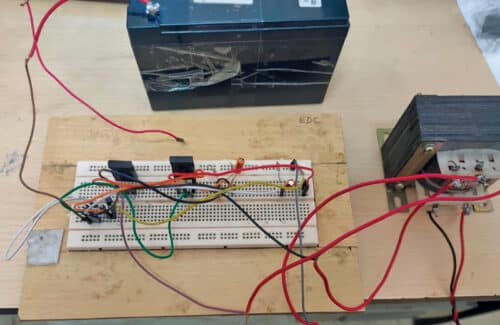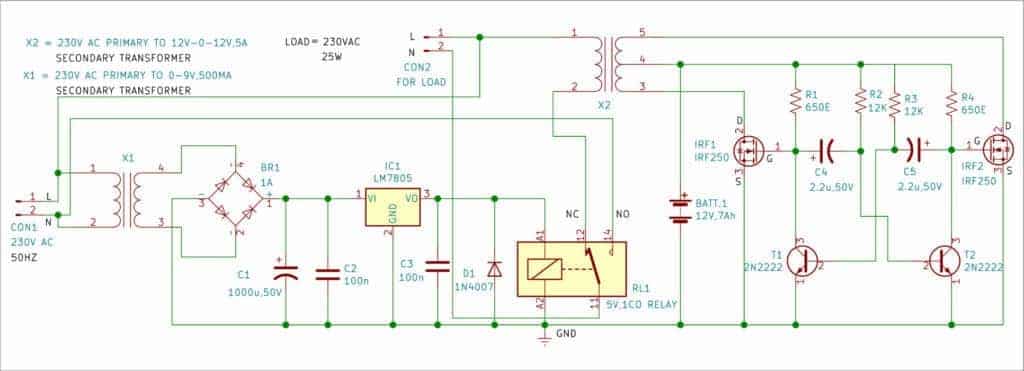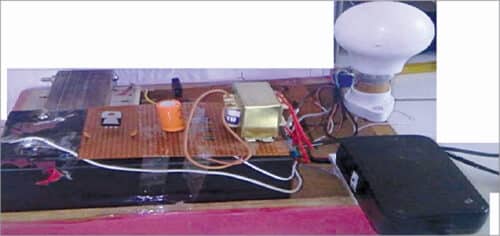 There are different types of inverters available in market, but their circuits are generally complex, so their cost is high. Here is a proposed low-cost inverter circuit based on MOSFET IRF250, which can also be used as an emergency light.
There are different types of inverters available in market, but their circuits are generally complex, so their cost is high. Here is a proposed low-cost inverter circuit based on MOSFET IRF250, which can also be used as an emergency light.
The circuit is simple and therefore can be wired even on a breadboard. The author’s prototype on a breadboard is shown in Fig. 1 while the circuit diagram is shown in Fig. 2.
The circuit comprises step-down transformers X1 and X2, bridge rectifier BR1, 5V voltage regulator 7805 (IC1), 5V single-changeover relay RL1, and a few other components. Capacitors C1 through C3, connected across the supply terminals, minimise ripples and other noise signals. Transformer X2 is an ordinary step-down transformer that is used here for the reverse function, that is, to step up the voltage.

The circuit works on 5V DC, which is obtained through the 230V AC primary to 9V, 500mA step-down transformer X1. The 230V AC mains is connected to the primary of X1 at CON1 in the circuit. The transformer’s 9V AC secondary is connected to bridge rectifier BR1 for rectification and filtered by capacitor C1. The rectified and filtered voltage goes to IC LM7805 to get regulated 5V DC voltage for the circuit.

In the inverter, this 5V DC is used to drive/energise relay RL1 when 230V AC mains supply is available. When RL1 is energised, its common point (pole) is connected to NO point.
When AC mains supply stops, the relay’s common point (pole) gets connected to NC point. This completes the connection of the load (bulb) via transformer X2, which is driven by IRF250 power MOSFET and 2N2222 transistors based circuitry to generate AC from transformer X2.
So, working of the circuit is simple. Transformer X1 is used to drive the relay when 230V AC mains supply is available to power the load (a bulb in this case). And when this supply goes off, transformer X2 is used to power the load via its primary—while its secondary is connected to the battery and the oscillator circuit. Thus, the bulb always remains on.
Construction and testing
The circuit can be assembled on a general-purpose PCB and enclosed in a suitable box. Connect 230V AC mains supply to primary terminals of transformer X1 across CON1. Connect the load (bulb) across CON2. The circuit is now ready to use. The author’s prototype assembled on a general-purpose PCB is shown in Fig. 3.

| Part List | |
| Semiconductors: | |
| IC1 | – LM7805, 5V voltage regulator |
| D1 | – 1N4007 rectifier diode |
| BR1 | – 1A, bridge rectifier |
| IRF1, IRF2 | – IRF250 MOSFET |
| T1, T2 | – 2N2222 NPN transistor |
|
Resistors (all 1/4-watt, ±5% carbon):
|
|
| R1, R4 | – 650-ohm |
| R2, R3 | – 12-kilo-ohm |
| Capacitors: | |
| C1 | – 1000µF, 50V electrolytic |
| C2, C3 | – 100nF ceramic disc |
| C4, C5 | – 2.2µF, 50V electrolytic |
| Miscellaneous: | |
| CON1-CON2 | – 2-pin connector |
| RL1 relay | – 5V, single changeover relay |
| Batt.1 | – 12V, 7Ah battery |
| X1 |
– 230V AC primary to 9V, 500mA secondary transformer
|
| X2 |
– 230V AC primary to 12-0-12V, 5A secondary transformer
|
|
– General-purpose PCB/ Breadboard
|
|
| – 230V, 25W bulb (load) | |
| – Heatsinks for IRF250 |
While assembling the circuit, use heavy-duty wires between the battery and transformer X2, and between the load and MOSFET, as they will be carrying higher current. Also, use heatsinks for the two MOSFETs.
EFY note. The design does not have a charger circuit, so ensure that the battery is fully charged before it is used.
Rakesh Jain, with a master’s in VLSI, B.E. in electronics and communications, and diploma in electronics, is Assistant Professor in ECE Department of Geetanjali Institute of Technical Studies, Udaipur. His research areas are sensors and microcontrollers; has 21 copyrights and 3 Indian patents to his credit








